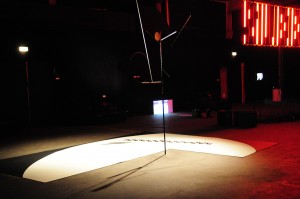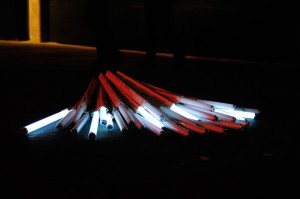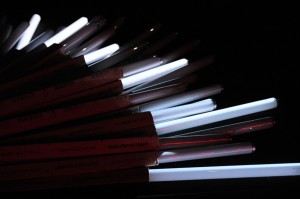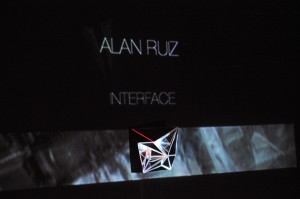Issue 28 11.20.13

Interview with Helen Homan Wu
Co-Curator of Navigating Darkness at the Tape, Berlin and founder of Opalnest multimedia production agency
By Kristin Trethewey
Located in an old warehouse near the Hamburger Bahnof, The Tape, functions as a venue for music and art exhibition in Berlin. Most recently the one-night show, Navigating Darkness curated by Helen Homan Wu and Mira O’Brien explored the interrelationship of lightness and darkness. The exhibition presented almost thirty artists showcasing video, sculpture, performance and sound for one night only. I was able to interview Helen Homan Wu currently in Shenzhen, China about the role of video in the exhibition and their intent on coaxing viewers through the space via sound and light.
http://opalnest.com/navigatingdarkness.html
KT:Navigating Darkness focused on the interconnection between light and darkness using sound to guide the viewer through the exhibition space. Many of the works played with visual perception. Can you outline some key projects? Which ones succeeded in the illusory experience and the suspension of disbelief within the exhibition on a whole?
HHW:When Mira O’Brien (co-curator) approached me about the project, I was immediately drawn to the unique architectural settings of the Tape Modern space. After hearing her describe what the space is like (cavernous, dark, industrial with a stage), and doing my own research, I knew this had a huge potential for curatorial experimentation. I began looking back at the Tape Modern’s previous programmes and found that an impressive amount of artists had shown there. Since I’m in New York and not at the space in Berlin physically, I did more research than I normally would to get a sense of the space as much as I can before curating anything for it. Mira had initiated the project with the theme being light/darkness, reflection/shadow, so I worked my ideas towards that to include sound and performative works.
There are a few works that I can point out, but I’m really intrigued by the artist Andy Graydon’s work on many levels – his way of communication, his processes, the diversity in his intermedia practices, and his background as a filmmaker. For Navigating Darkness, he presented a pile of fluorescent tubes, something that must to be seen in person to be understood. The tubes themselves are salvaged material that no longer works, but instead the artist projects a light source onto them as if bringing them back to life. There is a lot of this going on in his work- a clever way of using simple technology, combining rough material with new media, playing with the viewer’s sense of place and perception – this experience can very easily draw you into his world.
Video as a medium is usually light emitting. This often causes problems for its presentation in the white gallery space. How did you consider presenting video within the Tape Modern space, which is quite large and dark? Did you see this space as an opportunity to show video pieces?
The dark atmosphere of the Tape Modern is naturally an ideal setting for light-emitting works. We did think about video pieces for Navigating Darkness but more as projections (or light works) than simply showing them glaring out from screens. Between Mira and myself, we wanted to be careful about the way videos were presented and not to overdo it with too many video works. Instead, we were focusing on how they were presented. Using projections, or the size and placement of the works became more of a theatrical approach. In a dark setting such as the Tape, light is a really powerful element and our visual perception becomes quite sensitive, and this engagement is something that’s really interesting to work with.
There were a number of works that were not light emitting, but seemed to reference the history of video. I noticed at least two references to the zoetrope, the forefather of video that produces the illusion of movement using a successive series of still images. What was the decision to include these works in the show?
Well, the theme of the show was light and darkness, shadow and reflection. And the
zoetrope definitely fits into this theme quite nicely. It’s a wonderful object that uses simple technology and never gets outdated. One of the other focuses in Navigating Darkness was to show sculptural works, works that will benefit from extreme light and darkness. I think many of the pieces worked well together because it was a good balance between light-emitting works and sculptural pieces.
Opalnest curates projects in geographically disparate locations. Can you tell us how this process works for you? Where do you find yourself physically most often and how much of your work can you accomplish remotely today?
Well, it’s definitely not easy! I’m somewhat of a bohemian, and actually still trying to tailor the best way to work to fit this situation. The principle behind Opalnest is that it aims to deliver a sensory experience to audiences, allowing them to come out of their comfort zones in that moment and hopefully be inspired to see or think with a different perspective. I think it’s a very fluxus principle as well, and somewhat spiritual in a sense that it’s about the audience’s needs of that moment. So based on these principles our projects can happen anywhere in the world, but I’d like to focus producing projects in cities as a way to help people break down barriers.
I would have say, I find myself spending most months in New York City, which is where I grew up, and can’t seem to leave. For about two to four months out of the year, I travel to where the projects take me (right now I’m working out of Hong Kong and Shenzhen). The show Navigating Darkness was the first exhibition that I curated and produced remotely without being in the space physically, and it was quite an interesting process. The process of planning, organizing, having meetings and to some extent looking at work, can all be done over the Internet these days. It’s fascinating how many online tools are available to us today for synching our workflows and having everything that we do documented. I think more and more people are catching up and developing systems to work via the web, but personally I still prefer to be present in person.
Your personal curatorial practice focuses on experimentation in a wide variety of mediums. Who are some interesting artists you are working with using video? Have you noticed common themes at play and how are they pushing boundaries within performance or artwork?
Right now I’m working with Katja Loher, Suki Chan, Richard Garet, Andy Graydon, Jacob Kirkegaard, Paul Clipson, Joao Vasco Paiva, – they lean towards earlier career. For more established artists, I really admire the work of Phill Niblock and Carsten Nicolai, who are both a part of the programming that I’m putting together during the 2011 Shenzhen-HK Architectural Biennale. Besides Jacob Kirkegaard, who is a sound artist, the above artists all incorporate the aesthetics of sound into their practice as a part of the process, and not as an after-thought. I think this collaborative process: artist-to-artist, sight and sound, becomes very performative and interesting. For example, Carsten Nicolai (aka alva noto) continuously collaborates with the French poet-sound artist Anne-James Chaton and the resulting body of work is extremely original- Nicolai’s highly minimalist visuals and intense electronics with AJ Chaton’s “poor” literature. Although they often create works for audio or video outputs, it’s best to see their live performances.
LINKS:
http://fonik.dk/works-sounds.html
http://joaovascopaiva.com/projects/
Helen Homan Wu is a multimedia curator who works between New York, Berlin and Hong Kong. Her projects involve curating contemporary visual art, new media art, experimental music, interactive installations and performance art. She is the founder of Opalnest, a production agency devoted to international cultural programming and the co-founder and director of Artcards an online resource for arts listings in New York, Miami, San Francisco, Los Angeles, London and Berlin. Helen is currently working in Shenzhen, China with the One World Expo, http://www.oneworldexpo.org/en/index.html and the 2011 Shenzhen & Hong Kong Bi-City Biennale http://opalnest.com/specialprojects/szhkb/index.html



